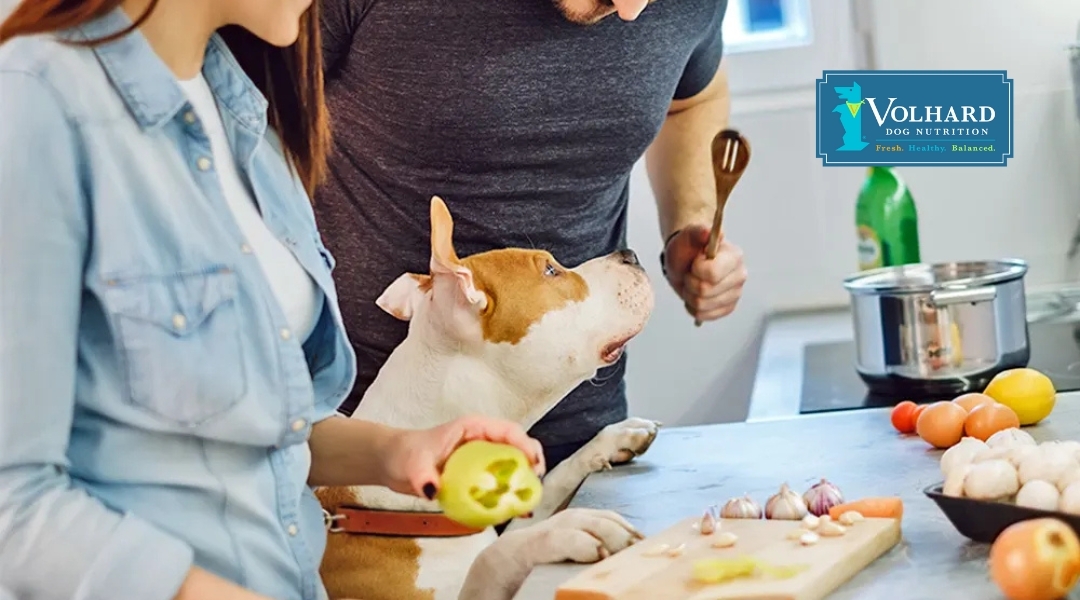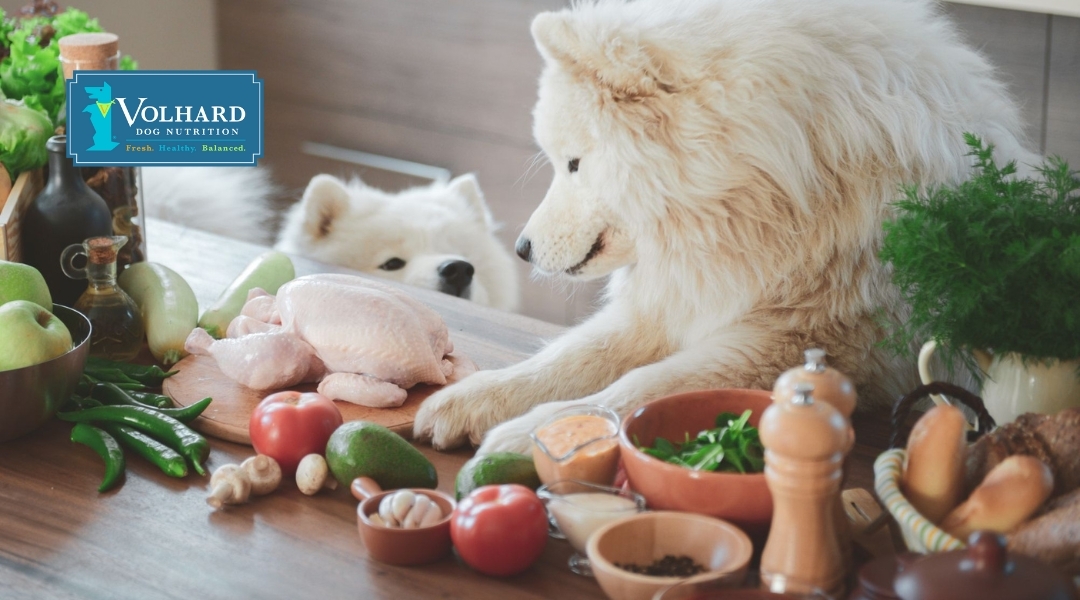Busting the Myth of Garlic Toxicity for Dogs! - Volhard Dog Nutrition
Posted by Volhard Dog Nutrition on Jun 27th 2025
If you’ve ever Googled “can dogs eat garlic,” chances are you were met with bold warnings and alarming headlines.
Our Volhard Dog Nutrition team believes in separating fear from fact. The truth is, garlic has been used for centuries as a healing herb across cultures, and yes, even for animals. So, how did this powerhouse of natural medicine get such a bad rap?
We’re busting the biggest myths about garlic and dogs. Garlic can support your dog’s immune system, heart, digestion, and skin, and it is safe to use in your dog’s diet.
Why Has Garlic Been Labeled as Toxic to Dogs?
Garlic has long been vilified in the pet world, often landing on lists of "dangerous" foods for dogs. Type it into any search engine, and you're likely to find warnings that equate it to poison, leading dog owners to avoid it entirely out of fear.
The reality is that garlic's bad reputation stems from a fundamental misunderstanding of the research, not from actual, widespread cases of toxicity in dogs.
The Research Problem: Extracts, Not Fresh Garlic
The most cited studies on garlic toxicity in dogs rarely involve the garlic you might add to your dog’s bowl. Instead, they use isolated compounds, garlic extracts, or massive quantities in clinical settings.
Fresh, raw garlic, the form used in traditional herbal medicine and recommended by holistic vets, is rarely the subject of these studies. Why? Because measuring the effects of whole plant medicine is difficult, research tends to favor easily standardized, synthetic forms.
This creates a significant gap between what is tested and how garlic is actually used in a natural, dietary context.

Misunderstood Dosages and Delivery Methods
The most infamous study contributing to garlic’s bad reputation was published in 2000. Researchers fed 5 grams of garlic per kilogram of body weight to a group of dogs daily for seven days.
For a 75-pound Golden Retriever, that equates to about 170 grams of garlic, or 34 cloves, every day. No dog or human, for that matter, would naturally consume this amount, nor would any responsible owner feed it.
Despite this extreme dose, the dogs in the study did not show any clinical symptoms of toxicity, such as vomiting, diarrhea, or lethargy. While changes were observed in red blood cell parameters, not a single dog developed hemolytic anemia, the condition most commonly feared when it comes to garlic.
Yet, the study's conclusion was taken out of context and repeated widely: garlic is unsafe for dogs. Lost in the conversation was a crucial detail: the reaction occurred at unrealistic levels of consumption, using a form of garlic not reflective of how it’s used in fresh, medicinal doses.
In reality, there is no robust evidence showing that small, appropriate amounts of fresh garlic are toxic to healthy dogs. A 2004 reassessment recommended garlic in moderation due to its health benefits.
Additionally, the FDA continues to list garlic as a permitted ingredient in pet food, and many holistic veterinarians have used it successfully for decades.
Garlic, like any supplement or herb, when prepared and dosed correctly, can offer a wealth of health benefits without putting your dog at risk.
Garlic Poisoning in Dogs: What You Actually Need to Know
Despite the widespread concern about garlic, true garlic poisoning in dogs is extremely rare and almost always the result of excessive consumption.
Clarifying Garlic Toxicity Dog Symptoms
In extreme cases where a dog consumes a large amount of garlic (think dozens of cloves in one sitting), potential symptoms of toxicity can include:
- Fatigue or lethargy.
- Pale gums.
- Rapid breathing.
- Vomiting or diarrhea.
- Increased heart rate.
- Discolored urine.
Which Dogs Should Avoid Garlic?
Although most healthy dogs tolerate garlic very well in the right dose, there are some cases where caution, or avoidance, is advised:
- Dogs with anemia or pre-existing red blood cell disorders.
- Dogs on blood thinners, insulin, heart medications, chemotherapy, or immunosuppressants.
- Pregnant or nursing dogs, unless approved by a vet.
- Breeds with known sensitivities to garlic, such as Shiba Inus and Akitas, may require more careful dosing.
If your dog falls into any of these categories, speak with a holistic veterinarian before adding garlic to their diet.

How to Safely Introduce Garlic to Your Dog’s Diet
Using garlic safely is all about dosage, quality, and preparation.
- Start Small: Begin with a fraction of the recommended amount to allow your dog to adjust.
- Use Fresh, Organic Garlic: Avoid jarred, pre-peeled, or processed forms; they lack medicinal value.
- Activate Allicin: Chop, crush, or mince garlic, and let it sit for 10–15 minutes before serving.
- Measure Properly: Use teaspoon measurements based on your dog’s weight (e.g., ⅓ tsp for a 10 lb dog).
- Observe Your Dog: If you notice any signs of discomfort, pause and reassess with your vet’s guidance.

The Healing Power of Garlic for Dogs
Garlic is one of nature’s most powerful medicinal herbs. Used for centuries across cultures to promote wellness and fight disease, garlic has earned its place in both human and animal health traditions.
6 Ways Garlic Can Help Your Dog
1. Boosting Immunity with Allicin
At the heart of garlic’s healing power is allicin, a potent sulfur-containing compound formed when fresh garlic is chopped or crushed. Allicin is responsible for garlic’s strong antimicrobial, antiviral, and antifungal effects.
For dogs, this means extra protection against infections, improved immune defense, and a more resilient gut microbiome, especially helpful during seasonal changes or periods of stress.
2. Natural Detox Support and Liver Health
Garlic supports healthy liver function by stimulating detoxification pathways and encouraging the breakdown of waste products before they enter the bloodstream. It promotes the growth of beneficial bacteria in the digestive tract while helping to eliminate harmful pathogens.
For dogs regularly exposed to environmental toxins, medications, or processed foods, garlic offers an excellent natural detox tool.
3. Supporting Cardiovascular Function
Garlic is well known for improving circulation, reducing cholesterol buildup, and helping maintain normal blood pressure. Its anti-platelet and vasodilatory properties support heart health in aging dogs or breeds prone to cardiovascular issues.
Garlic can also help thin the blood naturally, improving overall oxygen and nutrient delivery throughout the body.
4. Flea and Tick Prevention: Garlic as an Insect Repellent
Fleas and ticks are more attracted to unhealthy dogs with compromised immune systems.
Garlic helps repel these pests by releasing sulfur compounds through the dog’s skin and coat oils.
With consistent use during flea and tick season, it creates a natural barrier that makes your dog far less appealing to biting insects, without relying on chemical-laden spot treatments.
5. Garlic is Good for Dogs’ Skin
Garlic’s antifungal and antibacterial effects can improve skin conditions from the inside out. It helps clear up flaky or irritated skin, supports healthy oil production, and contributes to a shiny, resilient coat.
6. Food Stagnation, Asthma, and Beyond
Garlic is often used in Traditional Chinese Veterinary Medicine for dogs with food stagnation (poor digestion or bloating), respiratory issues like asthma, and even diabetes or early-stage cancer.
Its ability to move blood, eliminate toxins, and warm the system makes it a go-to for holistic practitioners who use food as medicine.

How Much Garlic Can Dogs Eat Daily?
Because garlic clove sizes vary significantly, using measuring spoons instead of counting cloves offers more consistent dosing. Once garlic is chopped, minced, or crushed, you can measure it in teaspoons based on your dog’s weight.
Volhard’s Dosage Guidelines (based on weight):
- 5 lbs: ⅙ tsp.
- 10 lbs: ⅓ tsp.
- 15 lbs: ½ tsp.
- 20 lbs: ⅔ tsp.
- 30 lbs: 1 tsp.
Always start with a lower dose and gradually build up to the full amount over a few days to ensure your dog adjusts well to the taste and effect.
The Best Way to Prepare Garlic for Dogs
To unlock garlic’s medicinal power, chop, crush, or mince a fresh clove and let it sit for 10 to 15 minutes. This activates the enzyme alliinase, which converts alliin into allicin. Once allicin forms, the garlic is ready to be mixed into your dog’s food.
If you skip this waiting period, you lose most of garlic’s therapeutic value.
Always choose fresh, organic garlic still in its husk. Pre-peeled or jarred garlic often contains preservatives and has lost much of its enzymatic activity. The fresher the garlic, the more potent and effective it is.
If you’re going to use garlic, stick with raw and freshly prepared; it’s safer and far more effective.
- Garlic powder: Often over-processed and oxidized, with little to no allicin remaining.
- Garlic oil: Not standardized and may cause digestive upset or even toxicity in concentrated amounts.
- Processed garlic: Usually lacks enzymes and may include flavorings, fillers, or binders that reduce digestibility and medicinal effect.
Are Garlic Supplements Safe or Effective?
Garlic powder is often deodorized and devoid of active allicin. Without the enzymatic reaction, it loses most of its therapeutic value. Additionally, it’s more challenging to control the exact dose, which increases the risk of overdosing or underdosing.
Some flea and tick repellents use garlic pills or tablets, often blended with brewer’s yeast. While the concept is appealing, many of these products contain too little active garlic or use dried forms that offer minimal protection. Results are inconsistent at best.
Garlic oil is sometimes recommended for ear infections due to its antimicrobial effects. However, topical application can be tricky; if not properly diluted, garlic oil can irritate the sensitive skin in a dog’s ear.
Fresh raw garlic is superior to supplements. While certain cold-pressed or extract-based products may retain some benefits, they rarely match the potency or full-spectrum action of fresh cloves.

Questions About Garlic or Your Dog’s Diet? Book a Nutritional Consultation with Volhard
For more advice on dog nutrition, health, and training, contact us and check out our other blogs, too!
Volhard Dog Nutrition and its expert canine nutrition coaches offer online consultations to help more dog parents discover why and how to feed their dogs the healthiest foods!
Speaking to a Volhard canine nutrition coach will help you understand the inseparable relationship between healthy food, a healthy body, and a healthy mind.
If you want to contact one of our Volhard canine nutrition coaches, you can do so by utilizing our Live Chat feature or scheduling a consultation.
References
- Allium Species Poisoning in Dogs and Cats, www.researchgate.net/publication/278718392_Allium_species_poisoning_in_dogs_and_cats. Accessed 10 June 2025.
- Lee KW; Yamato O; Tajima M; Kuraoka M; Omae S; Maede Y; “Hematologic Changes Associated with the Appearance of Eccentrocytes after Intragastric Administration of Garlic Extract to Dogs.” American Journal of Veterinary Research, U.S. National Library of Medicine, pubmed.ncbi.nlm.nih.gov/11108195/. Accessed 10 June 2025.

